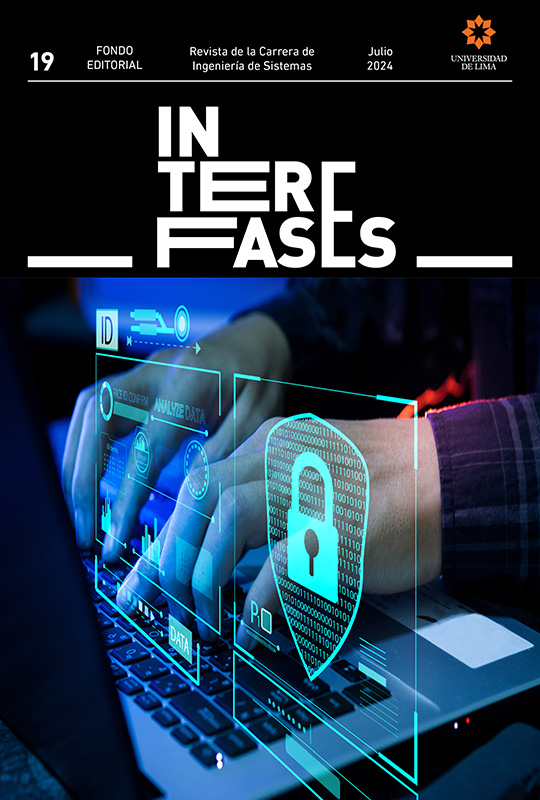Una revisión sistemática de literatura sobre implementaciones de sistemas de control de tráfico
DOI:
https://doi.org/10.26439/interfases2024.n19.6779Palabras clave:
control de tráfico, métodos, algoritmos, modelos, YOLO, implementacionesResumen
La congestión vehicular es una problemática que se manifiesta frecuentemente en ciudades con alta población y puede deberse a diversos factores, como la incorrecta planificación civil o el transporte público deficiente. Esto provoca un incremento en los accidentes de tránsito, la contaminación del aire, la pérdida de combustible y el descontento ciudadano. Por ello, se considera importante la implementación de sistemas de control de tráfico que genere fluidez en el tránsito vehicular y reduzca los tiempos de viaje. Este trabajo desarrolla una revisión sistemática de la literatura con el propósito de identificar los métodos, algoritmos y modelos más eficientes para la construcción de un sistema de control de tráfico. Los resultados identifican tres métodos y tres algoritmos considerados muy eficientes para el desarrollo de estos sistemas, de los cuales se resaltan el filtro bayesiano y las redes neuronales convolucionales. También se demuestra que You Only Look Once, conocido como YOLO, es el modelo de procesamiento de imagen más eficiente para estas implementaciones.
Descargas
Referencias
Abbas, J., Zhang, Q., Hussain, I., Akram, S., Afaq, A., & Shad, M. A. (2020). Sustainable innovation in small medium enterprises: the impact of knowledge management on organizational innovation through a mediation analysis by using SEM approach. Sustainability, 12(6), 2407. https://doi.org/10.3390/su12062407.
Adams, G. L., & Lamont, B. T. (2003). Knowledge management systems and developing sustainable competitive advantage. Journal of Knowledge Management, 7(2), 142-154. https://doi.org/10.1108/13673270310477342
Alasoini, T., Heikkilä, A., Ramstad, E., & Ylöstalo, P. (2007). Consultation as a new way to collect information in the Tykes Program: Preliminary Results. Workpolitical Journal, 2(2007), 55-71.
Bardin, L. (1977). L’analyse de contenu (Vol. 69). Presses universitaires de France.
Barbieri, J. C., & Álvares, A. C. T. (2003). Inovações nas organizações empresariais. Em Organizações inovadoras: estudos e casos brasileiros (pp. 41-63). Fundação Getulio Vargas.
Braun, V., & Clarke, V. (2012). Thematic analysis. Em. H. Cooper, P. M. Camic, D. L. Long, A. T. Panter, D. Rindskopf & K. J. Sher (Eds.), APA handbook of research methods in psychology, Vol. 2. Research designs: quantitative, qualitative, neuropsychological, and biological (pp. 57-71). American Psychological Association. https://doi.org/10.1037/13620-004
Brown, J. S. (1999). Sustaining the ecology of knowledge. Leader to Leader, 12, 31-36.
Cervo, A. L., & Bervian, P. A. (2002). Metodologia científica (5ª ed.). Prentice Hall.
Costa, J., Pádua, M., & Moreira, A. C. (2023). Leadership styles and innovation management: What is the role of human capital? Administrative Sciences, 13(2), 47. https://doi.org/10.3390/admsci13020047
Creswell, J. W., & Creswell, J. D. (2018). Research design: qualitative, quantitative, and mixed methods approaches (5ª ed.). Sage.
Damanpour, F., & Aravind, D. (2012). Managerial innovation: Conceptions, processes and antecedents. Management and Organization Review, 8(2), 423-454. https://doi.org/10.1111/J.1740-8784.2011.00233.X
Davenport, T. H., & Prusak, L. (1998). Working knowledge: How organizations manage what they know. Harvard Business Press.
Easterby-Smith, M., & Lyles, M. (2003). Re-reading organizational learning: Selective memory, forgetting, and adaptation. Academy of Management Perspectives, 17(2), 51-55. https://doi.org/10.5465/ame.2003.10025192
Fioravanti, V. L. S., Stocker, F., & Macau, F. (2023). Knowledge transfer in technological innovation clusters. Innovation & Management Review, 20(1), 43-59. https://doi.org/10.1108/INMR-12-2020-0176
Fitriati, T. K., Purwana, D., & Buchdadi, A. D. (2020). Dynamic capabilities and SMEs performance: The mediating effect of innovation (Study of SMEs in Indonesia). Em 1st International Conference on Science, Health, Economics, Education and Technology (pp. 457-464). Atlantis Press.
Gil, A. C. (1991). Como elaborar projetos de pesquisa. Editora Atlas SA.
Gressler, L. A. (2003). Introdução à pesquisa: projetos e relatórios. Edições Loyola
Gemünden, H. G., Salomo, S., & Hölzle, K. (2007). Role models for radical innovations in times of open innovation. Creativity and Innovation Management, 16(4), 408-421. https://doi.org/10.1111/j.1467-8691.2007.00451.x
Harrison, N., & Samson, D. (2002). Technology management: Text and international cases. McGraw Hill.
Jha, P., & Karn, B. (2019). Knowledge managements’ relevance in supply chain management process of Indian e-commerce companies. International Journal of Recent Technology and Engineering, 8(3), 1797-1805.
Jennex, M. E., & Zyngier, S. (2007). Security as a contributor to knowledge management success. Information Systems Frontiers, 9, 493-504. https://doi.org.10.35940/ijrte.C4612.098319
King, W. R. (2007). A research agenda for the relationships between culture and knowledge management. Knowledge and Process Management, 14(3), 226-236. https://doi.org/10.1002/kpm.281
Lakatos, E. M. & Marconi, M. A. (2006). Metodologia do trabalho científico: procedimentos básicos, pesquisa bibliográfica, projeto e relatório publicações e trabalhos científicos (5ª ed.). Atlas.
Lacombe, F., & Heilborn, G. (2005). Princípios e tendências. Editora Saraiva.
Linder, J. C., Jarvenpaa, S., & Davenport, T. H. (2003, July 15). Toward an innovation sourcing strategy. MIT Sloan Management Review. https://sloanreview.mit.edu/article/toward-an-innovation-sourcing-strategy/https://doi.org/10.5325/transportationj.56.4.0477
March, S. T., & Smith, G. F. (1995). Design and natural science research on information technology. Decision Support Systems, 15(4), 251-266. https://doi.org/10.1016/0167-9236(94)00041-2
Moraes, M. T. B. de, Malischeski, K., & Dandolini, G. A. (2023). Gestão do conhecimento e inovação organizacional: uma revisão integrativa. Perspectivas Em Gestão & Conhecimento, 13(esp), 146-161. https://periodicos.ufpb.br/ojs2/index.php/pgc/article/view/65569
Nonaka,I., & Takeuchi, H. (1997). Criação de conhecimento na empresa: como as empresas japonesas geram a dinâmica da inovação. Elsevier.
Polyakov, M., Khanin, I., Shevchenko, G., & Bilozubenko, V. (2023). Knowledge management in international companies: Specific features and information tools. Financial and Credit Activity: Problems of Theory and Practice, 3(50), 457-467. https://doi.org. https://doi.org/10.55643/fcaptp.3.50.2023.4061
Pompeo, D. A., Rossi, L. A., & Galvão, C. M. (2009). Revisão integrativa: etapa inicial do processo de validação de diagnóstico de enfermagem. Acta Paulista de Enfermagem, 22, 434-438. https://doi.org/10.1590/S0103-21002009000400014
Pontes, B. R. (2022). Planejamento, recrutamento e seleção de pessoal (Vol. 9). LTr Editora.
Quinn, J. B. (1992). Intelligent enterprise: a knowledge and service based paradigm for Industry. Simon and Schuster.
Raupp, F. M., & Beuren, I. M. (2006). Metodologia da pesquisa aplicável às ciências. Em: I. M. Beuren (Ed.), Como elaborar trabalhos monográficos em contabilidade: teoria e prática (pp. 76-97). Atlas
Senge, P. M. (2018). A quinta disciplina: a arte e prática da organização que aprende. Editora Best Seller.
Starkey, K. (1997). Como as organizações aprendem. Futura.
Sondhi, S.S., Salwan, P., Behl, A., Niranjan, S., & Hawkins, T. (2024). Evaluation of strategic orientation-led competitive advantage: the role of knowledge integration and service innovation. Journal of Knowledge Management, Vol. ahead-of-print No. ahead-of-print. https://doi.org/10.1108/JKM-07-2023-0660.
Takeuchi, H., & Nonaka, I. (2008). Criação e dialética do conhecimento. Em: Gestão do Conhecimento (pp. 17-38). Bookman
Tidd, J., & Thuriaux-Alemán, B. (2016). Innovation management practices: cross-sectorial adoption, variation, and effectiveness. R&D Management, 46(S3), 1024-1043.https://doi.org/10.1111/RADM.12199
Toffler, A. (1990). Powershift: Knowledge, wealth and violence at the edge of the 21st century. Bantam, London.
Valentim, M. L. P. (Org.) (2010). Gestão, mediação e uso da informação. Cultura Acadêmica
Venzin, M., Von Krogh, G., & Roos, J. (1998). Future research into knowledge management. Em: G. von Krogh, J. Roos & D. Kleine (Eds.), Knowing in firms: Understanding, managing and measuring knowledge (pp. 26-66). Sage. https://doi.org/10.4135/9781446280256
Wang, H. C., He, J., & Mahoney, J. T. (2009). Firm-specific knowledge resources and competitive advantage: the roles of economic-and relationship-based employee governance mechanisms. Strategic Management Journal, 30(12), 1265-1285. http://www.jstor.org/stable/27735491
Wang, C. L., & Ahmed, P. K. (2004). The development and validation of the organisational innovativeness construct using confirmatory factor analysis. European Journal of Innovation Management, 7(4), 303-313. https://doi.org/10.1108/14601060410565056
Whittemore, R., & Knafl, K. (2005). The integrative review: updated methodology. Journal of Advanced Nursing, 52(5), 546-553. https://doi.org/10.1111/j.1365-2648.2005.03621.x
Wiig, K. M. (1994). Knowledge management foundations: thinking about thinking-how people and organizations represent, create, and use knowledge. Schema Press.
Publicado
Número
Sección
Licencia
Los autores/as que publiquen en esta revista aceptan las siguientes condiciones:
Los autores/as conservan los derechos de autor y ceden a la revista el derecho de la primera publicación, con el trabajo registrado con la licencia de atribución de Creative Commons, que permite a terceros utilizar lo publicado siempre que mencionen la autoría del trabajo y a la primera publicación en esta revista.
Los autores/as pueden realizar otros acuerdos contractuales independientes y adicionales para la distribución no exclusiva de la versión del artículo publicado en esta revista (p. ej., incluirlo en un repositorio institucional o publicarlo en un libro) siempre que indiquen claramente que el trabajo se publicó por primera vez en esta revista.
Se permite y recomienda a los autores/as a publicar su trabajo en Internet (por ejemplo en páginas institucionales o personales) antes y durante el proceso de revisión y publicación, ya que puede conducir a intercambios productivos y a una mayor y más rápida difusión del trabajo publicado (vea The Effect of Open Access).
Última actualización: 03/05/21






